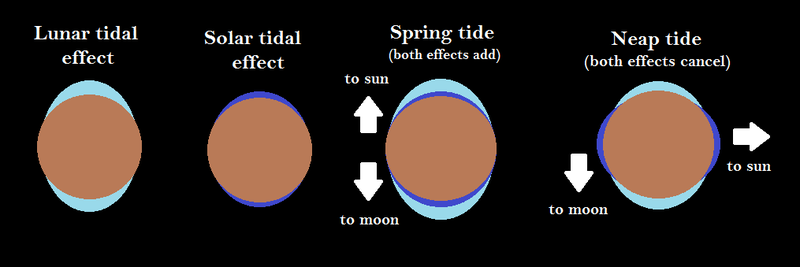Tidal force
The tidal force is a primary energy source and can be considered an primary energy flow. In fact, animals on Earth have been taking advantage of tides for as long as they have existed. Humans have used the kinetic and potential energy of tides to do work for them, from using the tidal movements for mill operations, to reducing the manpower needed sail in and out of bays and estuaries. However, electrical generation from tides is relatively new.
Tidal forces are changes in the gravitational potential energy of the Sun, Moon and Earth. These forces cause the periodic motion of the seas which create a temporary change in water levels that vary depending on location. Due to the inverse square law, the side of Earth closest to the Sun or moon will experience a greater force than parts further away.[1] This temporary change in gravitational force is what causes the variations in sea levels.
Sun and Moon
Interestingly enough, the Sun exerts a much stronger gravitational force on the Earth (about 175 times stronger when compared to the Moon) but has a smaller effect on the tides.[2] The reason for this is because of the inverse square law—the Earth's diameter is a tiny fraction of the total distance between the Sun and Earth which means that the difference in gravitational force across the Earth varies by a very small amount.[3] On the other hand, the Moon is much closer than the Sun, thus the difference in gravitational force from the Moon across the Earth is much greater. In fact, the Sun has approximately only 44% of tidal influence than that of the Moon.[2]

Additional information on tides
- Tides can be once per day or twice per day depending on the location on Earth[3]
- Spring/Neap Tides repeat every 15 days and Declinational Tides from Earth’s tilted axis repeat every 14 days – resulting in monthly pattern[2]
- Overall tidal cycle repeats itself every 18.6 years[3]
- Cyclical but repeatable and regular (unlike wind)[2]
- Gravitational forces felt on Earth from other planets exist but are so small they can be safely ignored!
- Tidal forces exist between other planets and their moons. The tidal force between Jupiter and Io creates violent volcanoes on Io. For more information on this please see NASA's website.
For a deeper exploration of tides please see HyperPhysics and NOAA.
For Further Reading
- Tidal power
- Tidal stream generator
- Gravitational force
- Kinetic energy
- Water
- Or explore a random page
References
- ↑ Chris Mihos, Department of Astronomy, CWRU. (Accessed July 28, 2015). Gravitational Tides Available: http://burro.astr.cwru.edu/Academics/Astr221/Gravity/tides.html
- ↑ 2.0 2.1 2.2 2.3 Hyperphysics. (Accessed July 28, 2015). Tidal Influences [Online] Available: http://hyperphysics.phy-astr.gsu.edu/hbase/tide.html
- ↑ 3.0 3.1 3.2 Keith Cooley. (Accessed July 28, 2015). The Moon and Tides [Online], Available: http://home.hiwaay.net/~krcool/Astro/moon/moontides

